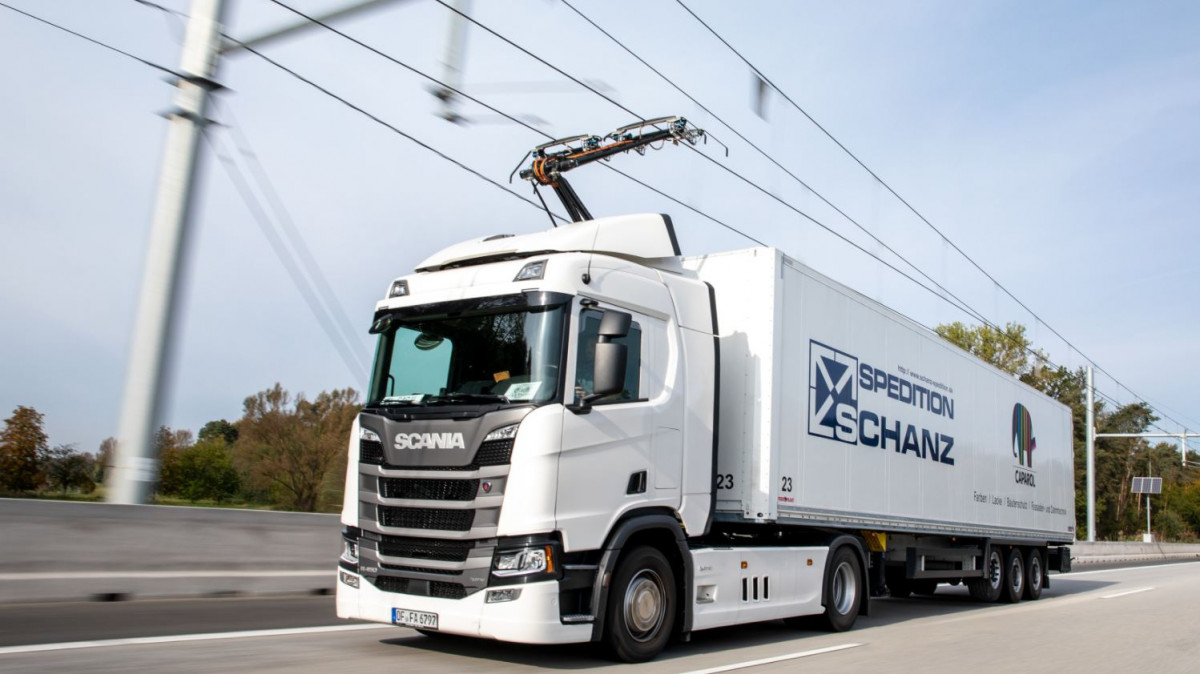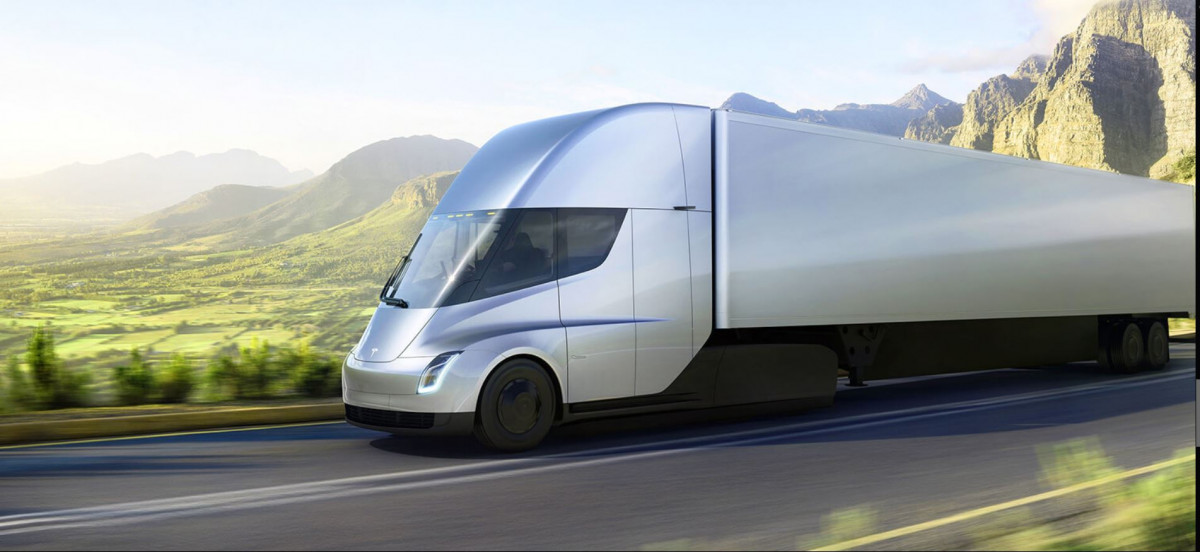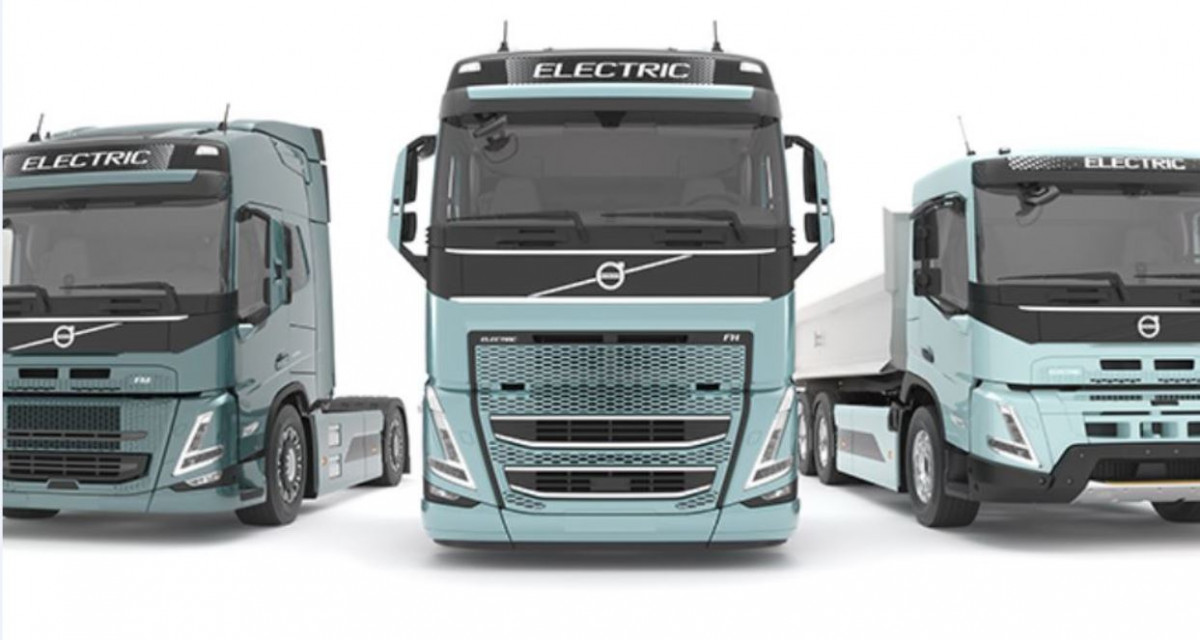Catenary trucks still stand chance in race to decarbonise road freight - researcher
Clean Energy Wire: Do you think the efforts to decarbonise transport are finally about to trigger serious change in heavy duty freight transport?
Florian Hacker: The EU's new emission regulation for heavy duty vehicles has finally fired the starting shot for the decarbonisation of trucks. It has triggered a race among truckmakers to get low-emission vehicles market-ready. Before this regulation, the truckmakers didn't take this issue very seriously, and didn't have clear targets for launching climate-friendly vehicles. But central framework conditions have now changed, and manufacturers must think of ways to achieve the EU targets of lowering emissions by 15 percent by 2025, and by 30 percent by 2030.
We have recently spoken to all the major truck manufacturers. The main takeaway: They no longer expect to achieve the new targets by improving the efficiency of combustion engines alone, although this approach has the lowest abatement costs in the short term. They also know full well that this approach will not get them anywhere in the longer run. They have realised that they can only achieve the long-term targets with alternative drives, and must plan the transition in good time.
The 2030 CO2 regulation has effectively sealed the combustion engine's fate. It will simply be extremely difficult to achieve substantial progress on emission reduction with this technology.
The 2030 CO2 regulation has effectively sealed the combustion engine's fate
Do you think the European truckmakers are now addressing the shift in earnest?
The manufacturers are now forced to get going, because it would be very expensive to miss the targets. The effort to lower emissions in trucking has also turned into a competitive question for them: 'Who will offer the competitive products in the future?'
Because we're dealing with entirely new technologies, they have to watch out for entirely new competitors. Even companies that up to now have hardly played a role in Germany or Europe could suddenly overtake them. This does not necessarily have to be Tesla, it could also be a Chinese company offering electric heavy duty trucks, for instance. The manufacturers know that they must be on their guard if they want to play a role in future world markets.
A few years ago, a wait-and-see attitude dominated at the truckmakers. They said: 'We have various alternative propulsion technology and fuel options, but none of them is market-ready yet. Let's just wait and see for a little bit.' Now this has definitely changed – one reason is technological maturity, but also new regulation. They simply can't afford this attitude any longer.
But my sense is that even the truckmakers feel a certain relief because at least the rules of the game have become clear, and there are rewards for moving. This creates a different dynamic, because now it has become perfectly clear that if you don't move, you will definitely lose out in the medium term. This creates the conditions for a race, and this is why they're now thinking seriously about how to get alternative drives into serial production, and how to market them to users.
In the passenger car market, we saw exactly the same development: Once the EU fleet emission regulation was in place, the large carmakers started to push the topic in earnest. Before then, the government had set targets for the roll-out of electric vehicles without changing the framework conditions. This approach can only elicit a tired smile, because this is not how a market operates. It doesn't care about a government 'wish list’, as long as it is not accompanied by the policy measures needed to trigger the shift. The same is now true for heavy duty vehicles.
When it comes to the various technology options to lower emissions in heavy-duty freight transport, it appears battery-electric trucks have recently made the greatest progress.
Yes, that's true. A few years ago the possibility of batteryelectric trucks was not even conceivable, and therefore wasn't even discussed. This has changed abruptly. I now believe that this technology will definitely materialise soon.
That is what the manufacturers are saying, too. It is the first thing they can do now. This is the area where they are technologically most advanced. They will definitely launch heavy trucks with batteries, but it depends on the purpose for which they are used.
We will see a number of battery-electric trucks with a range of up to 300 km at first, which is not at all a small amount – it's enough to cover a lot of vehicles. It shows that electrification will start in regional distribution transport. This is also the application with the greatest pressure to reduce local air pollution. Having this section run on battery-electric trucks is already technically feasible, and it requires little infrastructure because these trucks return to the depot in the evening, where they can charge. This looks set to become a germ cell for the technology, and is the short-term plan for all the manufacturers we spoke to. They want to go into series production by 2023/24, so that by 2025 they already have relevant numbers of battery-powered heavy duty vehicles.
Battery-electric trucks have a clear advantage over the fuel cell in terms of technological maturity. Even manufacturers who say 'We are betting on the fuel cell' do not assume that it will play a role in series production within five years. In general, many manufacturers are also in favour of using electricity directly because the efficiency of this approach will make the operation of trucks cheaper in the long run, and also minimises macroeconomic abatement costs in comparison to other technology paths.
However, some truckmakers continue to invest heavily in fuel cell technology, for example the cooperation between Daimler and Volvo launched earlier this year.
Fuel cells are a very expensive technology, and therefore it seems reasonable to spread high research and development costs over several shoulders, especially in view of the uncertainty as to whether we will ever achieve the quantities needed to make it profitable.
Nevertheless, many manufacturers are looking for cooperations in order to build up fuel cell knowledge. We simply don't know for certain how it will play out. It would therefore be too risky for manufacturers to concentrate on one technology alone. Nor do I believe that a single technology will eventually cover the entire road freight transport market, because the applications are too diverse for that. Some manufacturers, such as Daimler, have already invested too much in fuel cells over the years to throw the whole thing overboard, and give up their head start. If they can't find an application for fuel cells in road traffic now, it would really be money sunk. Here the interests of the manufacturers differ - depending on how much technological knowledge they already have.
But there is competition for use of hydrogen with other applications in transport, such as fuel production for aviation, or use in the industry sector - all of which rely on initially limited quantities of climate-friendly hydrogen. It's also much easier to get a dedicated hydrogen supply for these other applications going, because it will be concentrated in a few locations. Rolling out a hydrogen infrastructure over a large area for road transport poses much more logistical challenges.
From the manufacturers' point of view, battery technology also has a major advantage over fuel cells: There is a spillover effect from the much larger and much more research-intensive passenger car market. In our discussions, some manufacturers have described very enthusiastically that they can now benefit directly from the supply chains they built for the car market. This creates a self-reinforcing effect. As the fuel cell is out of the running in the passenger car market, it will be much more difficult for the commercial vehicle sector to make the necessary investments in research and development alone.
When evaluating the chances for fuel cells, I think it's very valuable to consider what happened in the car market. At the beginning, everybody said fuel cells are obviously the way to go because they approximate the current combustion engine system quite closely - users remain very flexible and can refill quickly, just like with conventional cars. And still, the system didn't succeed on a large scale – despite the fact that car trips are much more difficult to forecast, and users are less price-sensitive compared to the truck market. This precedent makes me slightly sceptical when it comes to fuel cells.
Do you think we'll use various low-emission technologies in the freight sector in parallel, also in the longer run?
Yes, I can imagine that. I don't think it's a done deal that we'll use the same propulsion technology for all applications. It might also not make sense, and therefore it's not necessary at this point to categorically choose one technology.
We don't need a commitment to a single technology before getting started, and we shouldn't wait any longer until we're really certain because we can take account of more technological developments. The development of a market itself can trigger technological leaps. This is why we must realise larger projects today.
On a technical level, we've reached the point where we need to try various systems on a larger scale. Many issues simply can't be solved in the laboratory, or at the small scale. We have to get all market participants into relevant projects. All options that are more or less market-ready will now have to be tested on a large scale.
We have to move away from too long-term thinking, and endlessly weighing up the pros and cons of various alternatives. We simply have to ask ourselves: Where do we stand today, and which decisions can be taken on this basis?
Do you believe that catenary systems remain a realistic option? The technology clearly has advantages when it comes to efficiency, but does it stand a chance to become implemented? There are no firm commitments from the government yet.
Yes, I think it still stands a chance, but it will require government action now. The state has to come out in favour of the technology by providing the infrastructure. It's not that different from the charging infrastructure for battery-electric vehicles, but here some of the charging points can be erected in non-public spaces, which lowers the entry threshold. But overhead lines must be installed on public road space, and this only works if the state takes the lead to initiate the infrastructure roll-out.
I can also imagine to rollout catenary technologies on specific corridors with heavy traffic. Once you reach a critical mass, this will create a market to use this infrastructure. I don't quite know why the truckmakers are not keen on this technology so far. They simply say: 'We don't have the confidence that the infrastructure can be rolled out quickly enough to allow the operation of vehicles.' I'm not so sure what makes them more optimistic regarding the charging infrastructure for battery-electric trucks, but perhaps it's simply the belief that the experience from the car sector will help. I wouldn't underestimate the fact that carmakers and utilities have gained quite a lot of joint experience in this area, and they have already learned how to cooperate to build chargers.
Also, it's important to keep in mind that Germany is not alone in the world. If we don't move ahead now, someone else will, and then the technology will be developed elsewhere. It won't depend on the German government alone. But I welcome that the Ministry of Transport is now also taking a closer look at catenary technology, and is planning concrete next steps. We mustn't be too hesitant, especially not when it comes to a technology whose advantages are plain to see. So far, the federal government has avoided making clear decisions on the direction to be taken. The short-term interests of important industrial players have certainly played a relevant role in these considerations. But even truckmakers that still bet on other technologies should have an interest in creating a market for a technology that definitely works. But my impression is that there is an increasing consensus at the EU level that we need decisions now for freight transport, also with a view to the Green New Deal. Germany's voice is extremely important in this regard. As a large transit country, it has quite some leverage. It would help enormously to have a clear position, at least for the coming years.
Don't you think we need a European approach to get catenary systems off the ground on a large scale?
When it comes to hydrogen fuel cells, we haven't even found an agreement on whether transport and storage of hydrogen should be in liquid or in gaseous form. This remains completely open. For battery-electric, we also need standardised chargers. So the problems of international cooperation affect all technologies. We'll just have to go ahead now and, if necessary, dismantle some infrastructure later if it turns out that there is a better long-term solution that should be rolled out. That's not the end of the world.





